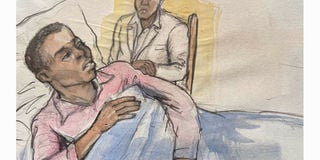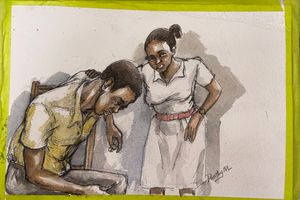
A man was accused by his family of causing the death of his younger brother, a university student, when he was alleged to have given poison to the deceased two months before the younger brother died. The two were in fact half brothers. And the case was not without ironies. The father of the two alleged in court that he saw his elder son holding something like a plastic glass and then pick something from his pocket that he put in the glass and then stirred and gave his brother to drink. The father was to tell court the drink was lemon with ice cubes in the glass. There were contradictions in the evidence of the father of the deceased and his wife, the mother of the deceased. The wife, who was seated next to her husband, told court that the deceased took water, soda and ice cream that evening.
It was ironical that a father would let his dear son take drink which he saw was laced with poison. It was equally ironical that he encouraged his son to finish the drink. It was submitted in court that no sane parent would allow his own children to poison themselves under his watch and do nothing about it there and then. The father of the deceased was even asked to explain this by the prosecution but he did not give any reasonable answer.
It also came out clearly in the court proceedings that the father of the children had night blindness and requested his son come and drive them home from the sauna that evening. It was therefore ironical that he could have seen his elder son lace the drink he gave his younger brother that evening.
One of the witnesses told court that the deceased complained of abdominal pain before he was admitted in hospital and that he (the witness) believed the cause of the pain was stomach ulcers and that when the deceased took drugs for ulcers he got well. The testimony of the mother of the deceased corroborated this piece of evidence. She told court that when her son complained of abdominal pain, some money was sent to him and he sort medical attention and was told that he had ulcers. And that upon taking the medicine that was prescribed her son was fine until the 8th of May 2021, when he was admitted in hospital. It is therefore ironical that the death of the patient was attributed to a poison he was alleged to have taken two months before his death.
When the deceased was admitted to hospital, it was his father and brother who provided the doctors in the hospital with the history of the illness of the patient. The two did not make mention of any suspicion of poisoning. These records were tendered in court. Clearly the story of poisoning was an afterthought after the death of the patient.
It is also inconceivable and unbelievable that someone can be poisoned with a very fast acting poison of the nature of Carbofuran, a pesticide, on 14th March 2021 and live for two months up to 15th May 2021 without manifesting signs and symptoms of the poison. The doctors stated the cause of death as acute pancreatitis and not poison.
The father of the deceased testified that his son confided in him before his death that his elder brother had poisoned him. However it was unbelievable that the father of the deceased did not act on this information; he did not inform the police to commence investigations. He testified in court that he informed the doctors that his son had drunk something but this was not captured in the clinical notes. Clearly he did not notify the doctors who may have given the deceased an antidote to the poison.
The father of the deceased told court of the purported bad relationship between the deceased and his half brother. He narrated an incidence in 2018 when the elder brother attempted to poison the deceased in a similar way. The ironies here were that there was not a single medical record to that effect and the mother of the deceased had no recollection of the same. The lawyers deemed his assertions presumptive. It was also ironical that the family continued to relate normally after these allegations.
The deceased tested positive for the Corona virus while in hospital and was on treatment for the same. After the patient died, the death was attributed, in the medical certificate of death, to pancreatitis with multiple organ failure and the Corona virus. This was contested by the father of the deceased when the results of the Corona virus test from a government facility turned out negative.
The doctors from the hospital told court that a patient may test positive for the virus on a particular day but may test negative a few days later especially if someone is on treatment as was the deceased. A negative test does not rule out the fact that someone once got infected with the virus.
The deceased was buried shortly after he died but without a postmortem examination; the body was exhumed and a postmortem examination was conducted ten weeks later. The cause of death was not established and samples were removed from the body that had been embalmed with formalin for toxicology tests. It is known that once a body has been treated with formalin, it is not advisable to remove samples for toxicology as the samples will have been contaminated, but also because it is difficult to extract poisons from such samples. However, the results from the laboratory indicated that the samples taken from the body of the deceased contained a pesticide.
The pathologists recommended that the samples be subjected to further testing in an independent laboratory and the actual concentrations of the poison in the various samples be determined. These were not done and the lawyers submitted that in the absence of qualitative test results the toxicology report was inconclusive and inaccurate as it did not show if the poison in the body of the deceased was actually in doses that could cause the death of a person.
There is a very strong likelihood that the samples were contaminated considering that pesticides are commonly used in agriculture. There is even a stronger possibility that the toxicology results were compromised. The most unlikely possibility is that the poison was administered when the deceased was in hospital.
To be continued








